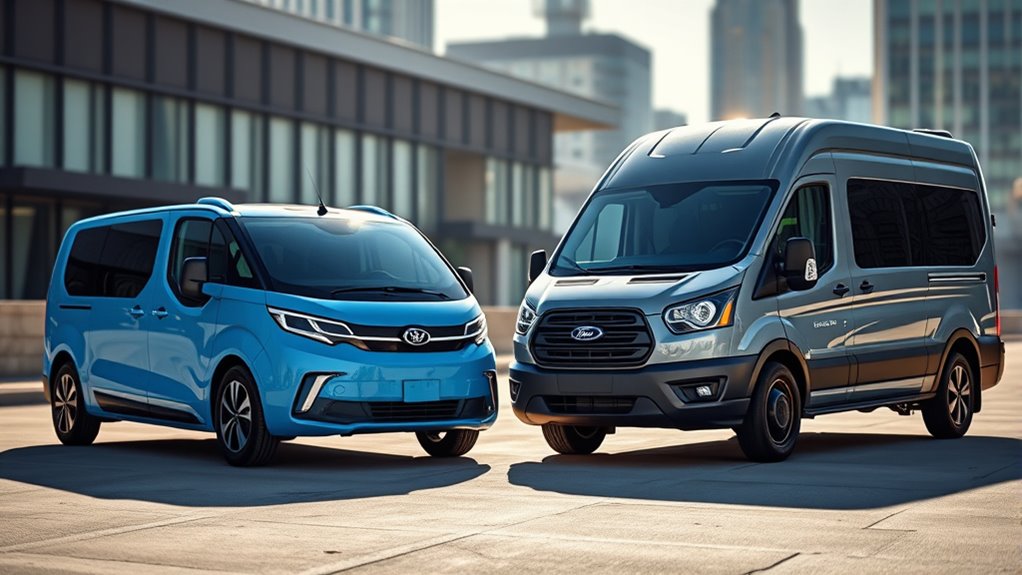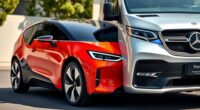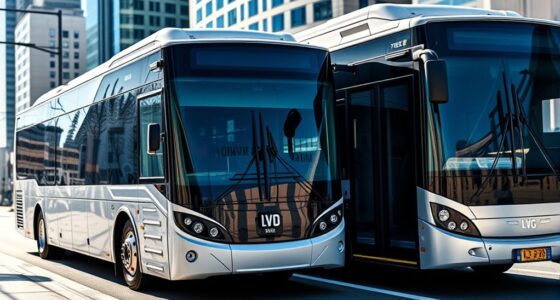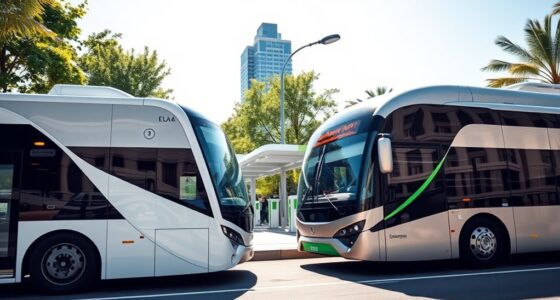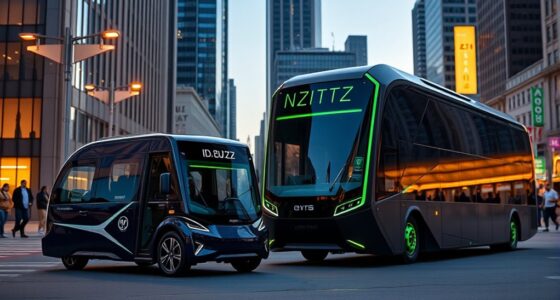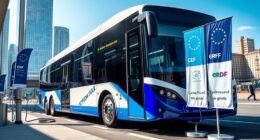If you’re choosing between the Volkswagen ID.Buzz and Ford E-Transit, consider your needs. The ID.Buzz offers style, better handling, and a longer range, ideal for personal use or flexible tasks. The E-Transit provides larger cargo space, higher payload capacity, and a more budget-friendly price for commercial fleets. Both are great options, but which suits your priorities best? Keep exploring to find which electric van aligns with your lifestyle or business goals.
Key Takeaways
- Ford E-Transit offers larger cargo capacity and higher payloads, making it more suitable for heavy-duty commercial use.
- Volkswagen ID.Buzz features a stylish, retro-inspired design with better handling and a more premium interior for passenger comfort.
- E-Transit is more budget-friendly with lower starting prices and established fleet support, while ID.Buzz has a higher price reflecting style and versatility.
- ID.Buzz provides faster charging and slightly longer range at higher speeds, ideal for highway driving; E-Transit excels in urban fleet efficiency.
- Overall, E-Transit is better for cargo and commercial utility; ID.Buzz is preferable for style, passenger versatility, and urban flexibility.
Price and Availability Comparison
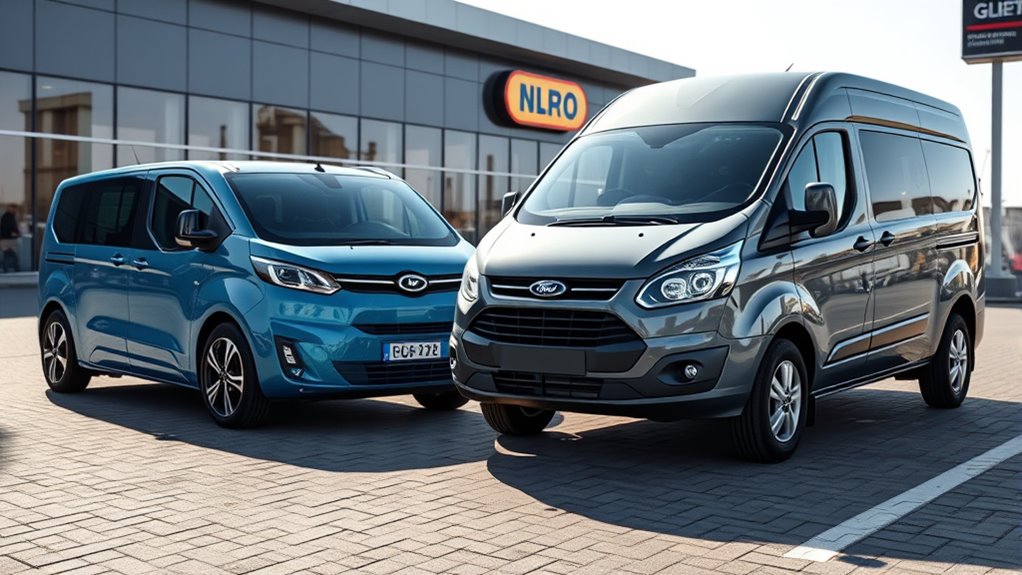
When comparing the price and availability of the ID.Buzz and Ford E-Transit, you’ll find that the Ford E-Transit Cargo Van typically starts at around $51,890, making it more budget-friendly than the Volkswagen ID.Buzz, which begins at approximately $61,545.
The E-Transit also offers a range of variants, including the E-Transit Custom, which in some markets aligns more closely with the ID.Buzz’s pricing.
Both vehicles are available globally, though Ford mainly emphasizes the UK and European markets, while Volkswagen targets a broader audience.
Availability can fluctuate due to supply chain issues, regional demand, and production capacity.
Both brands have extensive dealer networks, and electric vehicle options may further influence the overall affordability for buyers.
Cargo Capacity and Practicality
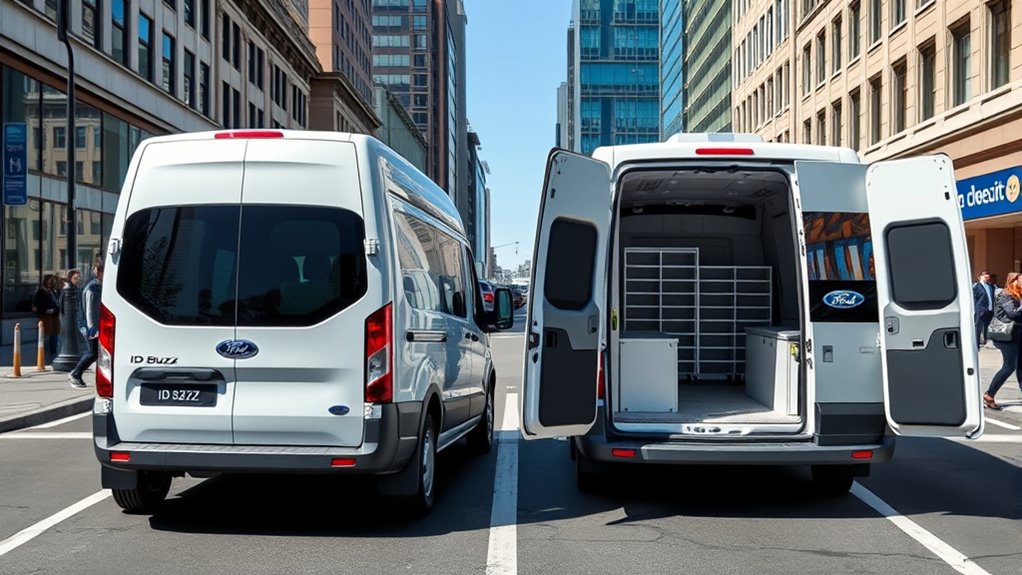
Cargo capacity and practicality are key factors to contemplate when choosing between the ID.Buzz Cargo and the Ford E-Transit.
When comparing ID.Buzz Cargo and Ford E-Transit, consider cargo space and practical features for your needs.
The E-Transit offers up to 15.1 cubic meters (536.4 cu ft) of cargo space, making it ideal for larger loads and demanding business needs. Its traditional configurations, larger load volume, and higher payload capacity—up to 3,880 pounds—enhance load management and versatility. Storage in a cool, dark place can help maintain the vehicle’s interior condition, indirectly supporting long-term practicality.
The ID. Buzz Cargo’s modular design provides flexibility and ease of loading but lacks detailed cargo volume data, suggesting it’s better suited for smaller, more adaptable loads. The modular design allows for customizable interior configurations, which can improve operational efficiency.
The E-Transit’s larger interior and tech features support efficient operations, while the Buzz Cargo’s customizable interior offers some practical benefits. Additionally, trustworthiness of the brand can influence long-term satisfaction and reliability.
Performance and Handling Dynamics
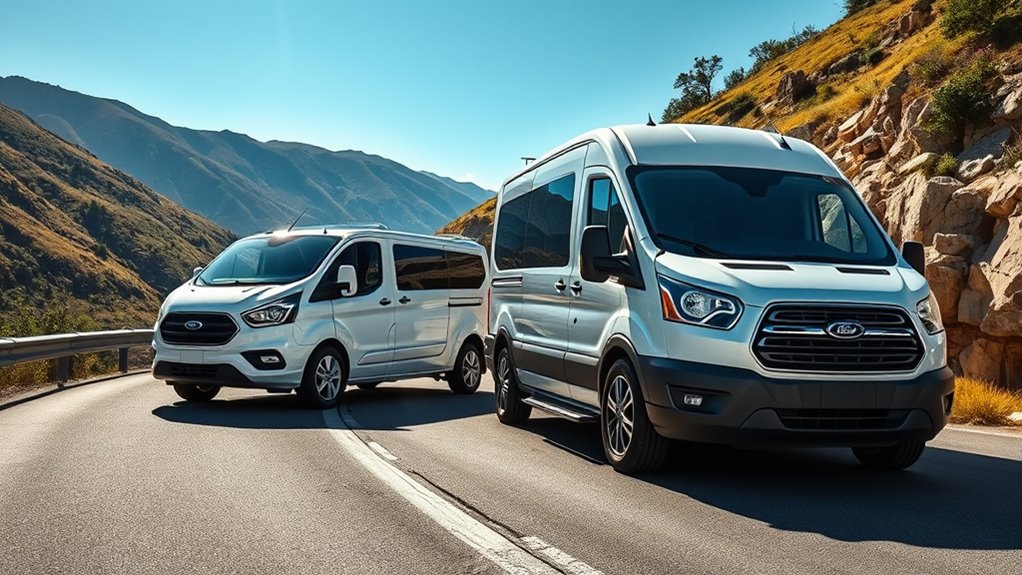
The Volkswagen ID.Buzz generally delivers more powerful options and higher torque compared to the Ford E-Transit, which prioritizes efficiency over raw performance. You’ll notice the ID.Buzz’s stronger acceleration and better handling on open roads, thanks to its lower center of gravity and balanced weight distribution. The ID.Buzz’s performance is also supported by its advanced content creation features, allowing for a more engaging driving experience. The E-Transit handles city driving well, with responsive urban acceleration and smooth ride quality, even under load. Both vehicles benefit from regenerative braking—brake-by-wire in the E-Transit and standard in the ID.Buzz—which enhances efficiency and control. Although the suspension in loaded conditions feels firmer, it doesn’t hinder city maneuverability. Additionally, the tuning options available for the ID.Buzz can further optimize its handling and performance. For example, vehicle dynamics adjustments can significantly improve ride quality and responsiveness. Furthermore, the performance tuning options can help customize the driving experience to suit different preferences. Overall, the ID.Buzz offers a more dynamic driving experience, while the E-Transit emphasizes practicality and stability for daily urban use.
Battery Technology and Charging Options
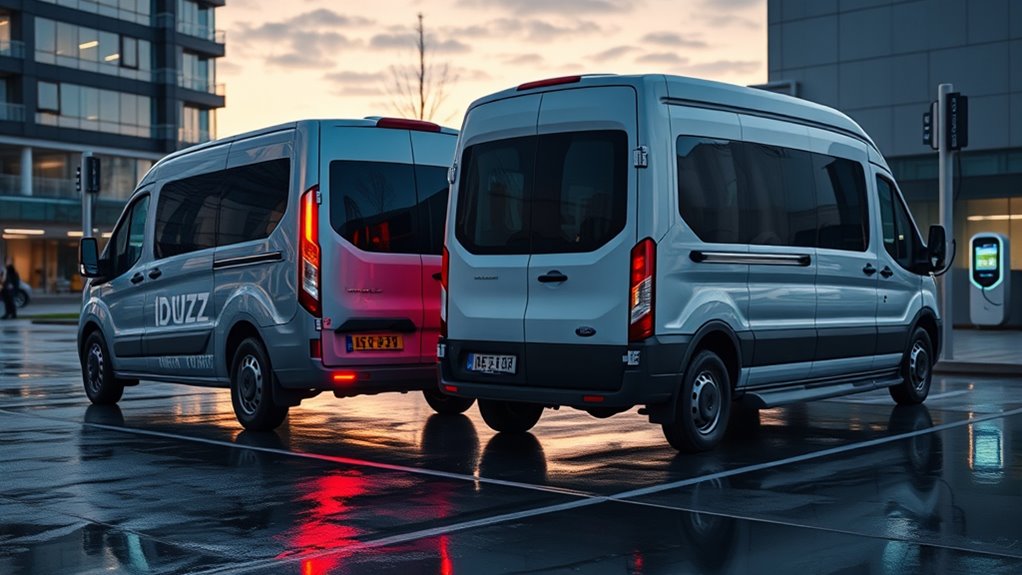
Both the Volkswagen ID.Buzz and Ford E-Transit feature advanced battery technologies tailored to their respective priorities.
The ID.Buzz has an 86.0-kWh liquid-cooled lithium-ion battery, offering a larger capacity and supporting fast charging up to 200 kW, which can charge from 10% to 80% in about 30 minutes. Additionally, the ID.Buzz utilizes thermal management to maintain optimal battery performance and longevity.
In contrast, the E-Transit provides multiple battery options, with a maximum of 68 kWh, and supports DC fast charging, though specific speeds are less defined. Advanced battery technology plays a key role in vehicle reliability and charging efficiency for both models.
Both vehicles accommodate home charging via Level 2 stations and support public charging with compatible ports. The ID.Buzz emphasizes thermal management with liquid cooling and clearer charging specifications, ensuring long-term performance.
Both vehicles support home Level 2 charging and compatible public charging options.
Meanwhile, the E-Transit’s battery design focuses on durability, though details are less explicit. Additionally, wireless charging is emerging as a convenient option for electric vehicles, enhancing charging flexibility.
Driving Range and Efficiency
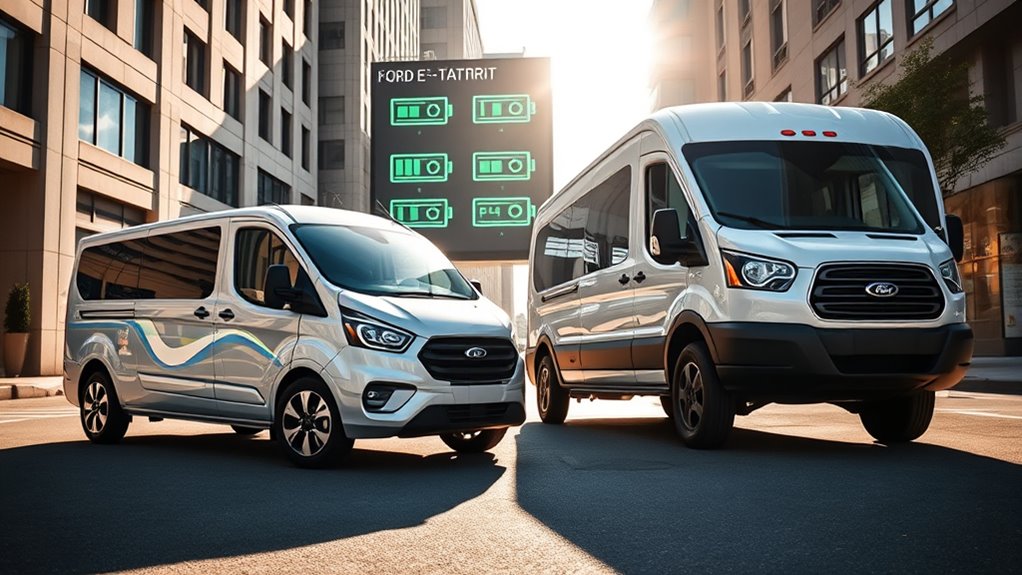
When comparing the driving ranges of the Volkswagen ID.Buzz and Ford E-Transit, real-world performance often differs from official claims.
The Ford E-Transit’s WLTP range is 230-307 km, but in practice, you’ll likely see around 200-230 km, depending on conditions.
The ID.Buzz’s WLTP estimate is up to 431 km, with EPA estimates around 234 miles, making it more efficient for daily urban use.
The E-Transit consumes about 28 kWh per 100 km, while the ID.Buzz claims just 20.3 kWh.
Efficiency drops with heavier payloads, cold weather, or aggressive driving.
Both vans suit short-range urban deliveries, but the ID.Buzz’s higher real-world range and lower energy consumption give it an edge for longer daily trips.
necessary cookies and other categories impact how data is collected and used during your journeys, influencing overall efficiency and user experience.
Design Features and Interior Functionality
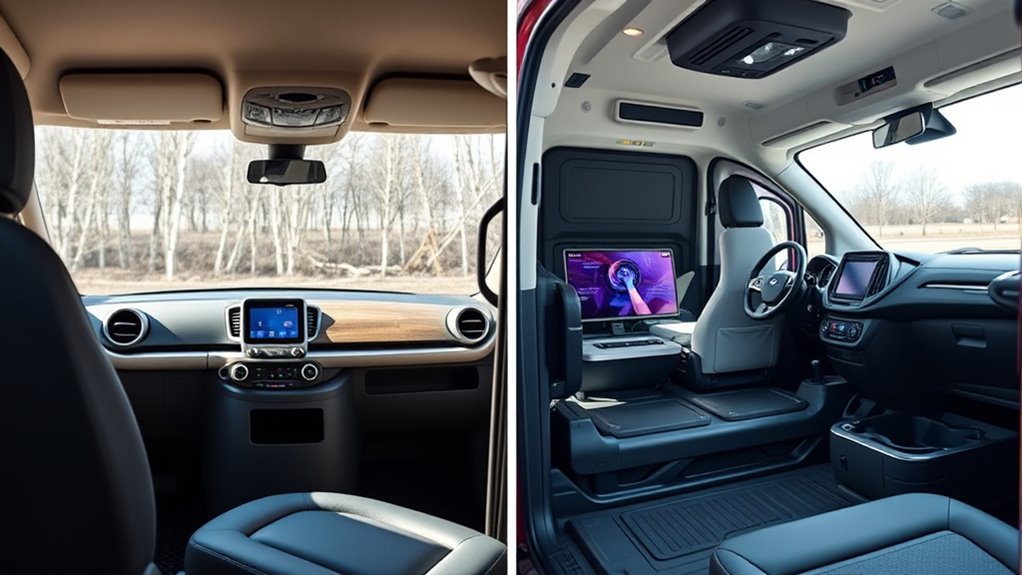
Have you ever wondered how the design and interior features of the Volkswagen ID.Buzz compare to those of the Ford E-Transit?
The ID.Buzz sports a retro-inspired, sleek silhouette with modern touches like LED lighting and streamlined contours, giving it a car-like front end. Its lowered load floor makes access easier, blending passenger comfort with practicality.
Inside, the ID.Buzz offers a driver-focused cockpit with a central touchscreen, contoured seats, and ambient lighting, emphasizing passenger comfort. The interior design of the ID.Buzz incorporates emotional expression and creativity, creating an inviting environment for passengers.
In contrast, the E-Transit features a boxy, functional design optimized for cargo space, with a high-roof option and durable materials. Its interior is utilitarian, with flexible seating options and a larger cargo area, supporting heavy-duty use. Additionally, the interior layout of the E-Transit is designed for adaptability, catering to various commercial needs.
The E-Transit’s interior also prioritizes functional durability, making it suitable for demanding work environments.
While the ID.Buzz leans toward comfort and style, the E-Transit emphasizes practicality and versatility.
Suitability for Commercial Use
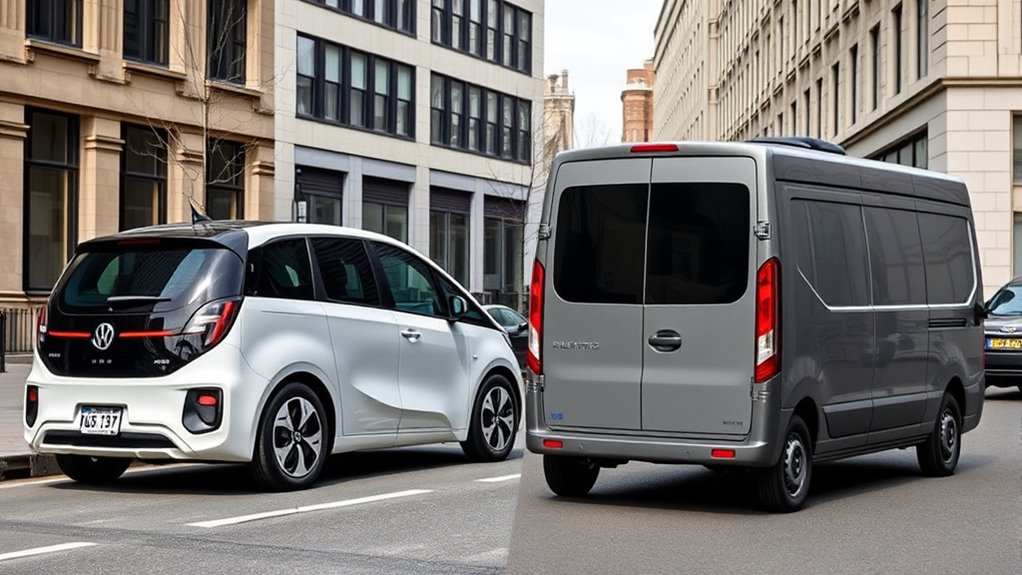
The suitability of the Volkswagen ID.Buzz and Ford E-Transit for commercial use hinges largely on their payload capacities, range, operational costs, safety features, and market acceptance.
You’ll find that the ID.Buzz cargo offers a lower payload, which may limit its use for heavy-duty transport, making it less ideal for tradies or demanding deliveries.
In contrast, the Ford E-Transit handles heavier loads and provides more load volume, aligning better with commercial needs.
The E-Transit’s range suits urban fleets, especially with its efficient operation and sufficient charging infrastructure.
Operational costs favor both models, thanks to lower fuel and maintenance expenses.
Additionally, safety features like advanced driver aids and high safety ratings make the E-Transit more appealing for fleet operations.
Market acceptance favors the established Ford, whereas the ID.Buzz’s new market presence offers a fresh choice.
Understanding market acceptance can be crucial in determining the long-term viability and support for each vehicle in a commercial fleet.
Considering electric vehicle technology is essential when evaluating their suitability for sustained commercial use.
Moreover, the technological advancements in EVs continue to improve battery life and charging times, making them more practical for daily operations.
A comprehensive understanding of the current state of EV infrastructure can further influence decision-making for fleet deployment.
Pros and Cons of Each Model
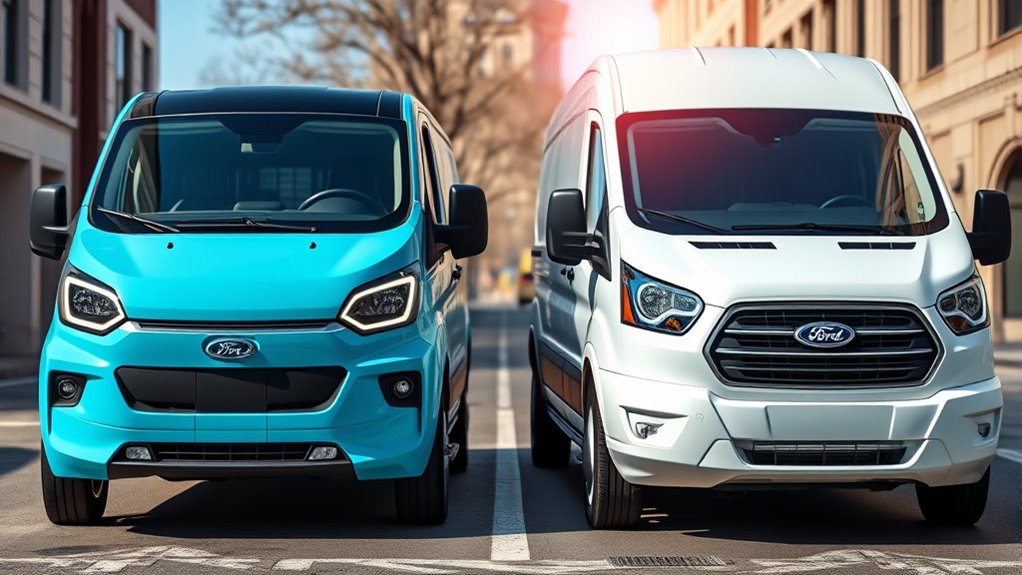
The ID.Buzz excels in style, offering a retro-inspired design, a spacious seven-seat interior, and a range of up to 264 miles WLTP. Its advanced aerodynamics boost highway efficiency, but cold weather can reduce range, and real-world mileage may dip to 150-190 miles at higher speeds. Charging is fast but can slow in cold conditions. The higher price reflects its lifestyle focus. Additionally, noise levels of modern heat pumps play a role in overall comfort, ensuring a quieter ride inside the vehicle, which is an important consideration for users seeking a Hyundai Tuning for improved vehicle acoustics. Ongoing technological advancements continue to enhance electric vehicle performance and user experience.
Which Electric Van Suits Your Needs Best
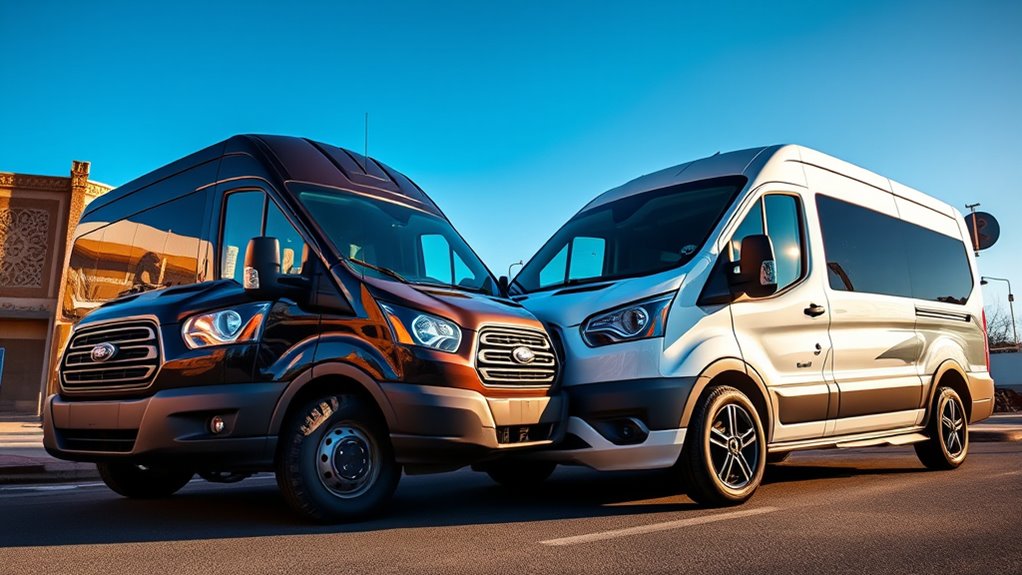
Choosing the right electric van depends on your specific needs and priorities.
Selecting the perfect electric van hinges on your unique requirements and priorities.
If you’re looking for affordability and maximum cargo space, the Ford E-Transit is your best fit, with a lower starting price and larger load capacity. It’s ideal for fleet owners and businesses needing practical, versatile transportation, especially since it’s available in the U.S. market.
On the other hand, if you prioritize longer range, stylish design, or targeting European markets, the Volkswagen ID.Buzz offers a modern, compact option with strong performance, featuring 210kW of power and 550Nm torque.
The ID.Buzz suits those seeking a versatile vehicle for passenger and cargo use, but its higher price and limited availability in the U.S. make it less accessible for some.
Choose based on your budget, usage, and location. Additionally, understanding the benefits of space maximization and organization can help you make the most of your vehicle’s interior, whether for commercial or personal use.
Frequently Asked Questions
Are There Any Government Incentives for Purchasing These Electric Vans?
You’ll find that government incentives can help reduce your costs when buying electric vans like the ID.Buzz or Ford E-Transit. The federal government offers tax credits up to $7,500 if the vehicles meet specific criteria.
Many states or local areas also provide additional rebates or incentives. Check eligibility beforehand, as manufacturer certifications and regional programs vary.
But these incentives can make your electric van purchase more affordable.
How Do Maintenance Costs Compare Between the ID.Buzz and E-Transit?
You might worry about maintenance costs, but electric vans like the ID.Buzz and E-Transit actually keep expenses low. Both require less servicing, fewer repairs, and have longer-lasting parts.
The E-Transit benefits from Ford’s strong support network, making maintenance straightforward.
Meanwhile, the ID.Buzz’s innovative design could lead to new efficiencies.
What Are the Warranty Terms for Each Vehicle’s Battery?
You want to compare the battery warranties for these electric vans. The ID.Buzz offers an eight-year or 160,000 km warranty covering manufacturing defects, with normal capacity loss not covered unless below 70%.
Ford’s E-Transit provides a similar eight-year or 100,000-mile warranty, also covering defects.
Both warranties include exclusions for misuse and maintenance issues, giving you peace of mind over long-term ownership.
Regional differences may apply, so check specific terms in your area.
Can the Vans Be Customized for Specific Commercial Needs?
You might think customization options are limited, but both vans offer tailored solutions for commercial needs. The ID.Buzz provides real-time 3D wraps, heritage-inspired designs, and modular cargo features, making it versatile for branding and logistics.
The E-Transit excels with pre-wired electrical systems, fleet management integrations, and upfit compatibility. Either way, you can adapt these vans to fit your specific business, enhancing productivity and brand visibility.
How Do Safety Features Differ Between the Two Models?
You’ll find that both electric vans prioritize safety with similar features like adaptive cruise control, emergency braking, blind spot monitoring, lane assist, and active safety options. They each have robust crash safety measures, including crumple zones and battery protection.
Their high-voltage systems are designed for safety, with automatic isolation and thermal management. Overall, you get comparable safety protections, though specific technology integrations may vary slightly between models.
Conclusion
So, whether you choose the sleek id.buzz or the reliable Ford e-Transit, one thing’s certain: your business will never run out of options—or surprises. Ironically, the more tech and range these vans pack, the more you might find yourself debating which one truly fits your needs. In the end, it’s less about which van wins and more about which one convinces you it’s the right choice—because, after all, that’s what matters most.
